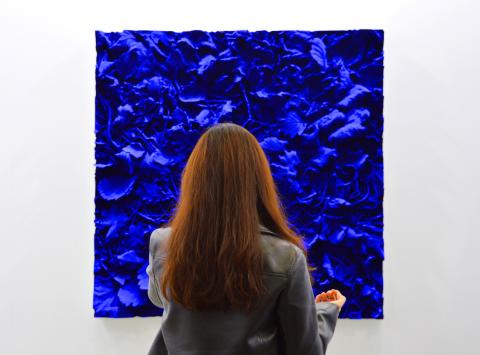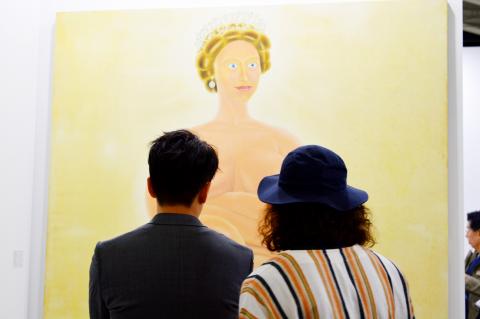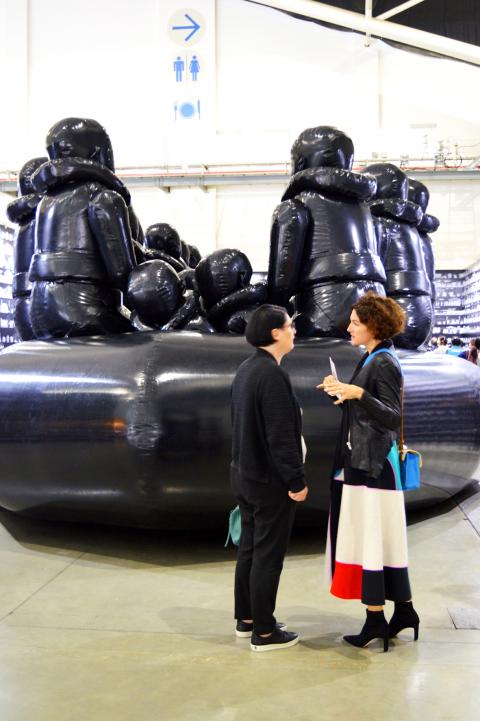“We hope to make Taipei Dangdai the most important event in the art scene around the world and in Asia,” was co-director Robin Peckham’s speech opening, speaking in Mandarin as a nod to the local market. Returning for a second year, Dangdai’s (台北當代) goal is to put Taipei on the map for the art world.
Asia is already a leading force in the global art market, and it is only expected to grow in importance in the upcoming years. However, which cities play a key role is constantly changing — especially in light of unstable business in Hong Kong over the last year.
“Taipei city is vibrant and collectors are hungry,” said Mariko Kawashima, director of Axel Vervoordt Gallery Hong Kong, one of the newcomers this year amongst 99 galleries — 23 of which have spaces in Taiwan.

Photo: Ella Csarno
Dangdai’s co-founder Magnus Renfrew said there is interest from galleries around the world in potentially joining next year.
COLLECTORS DO THEIR HOMEWORK
International galleries were impressed by the Taiwanese crowd.

Photo: Ella Csarno
“For a small country, it’s astonishing that there are so many collectors,” said Rachel Lehmann, co-owner of Lehmann Maupin. “They do their homework very well, and they collect in depth.”
It was a sentiment echoed by gallerist Sean Kelly.
“People here are very sophisticated, they understand quality,” Kelly said.

Photo: Ella Csarno
Though Kawashima said they are still learning about Taiwanese collectors, Kelly believes in bringing recognizable names and leading works to Taiwan. Indeed, the number of artworks from world-renowned artists like Marina Abramovic, Anish Kapoor, Ai Weiwei (艾未未) or Julian Opie have gone up considerably.
Galleries reported successful sales. David Zwirner sold multiple artworks within the first two hours of the fair, mostly to Taiwanese collectors. TKG+, the contemporary branch of Taiwanese Tina Keng Gallery (耿畫廊), said they were happy with the results, and, perhaps more importantly, made connections to new collectors.
NOT JUST FOR PROFIT
Backed by the Ministry of Culture, the Bureau of Foreign Trade and Taipei’s Department of Cultural Affairs, Dangdai provided a platform for many artists who were never presented in Taiwan before.
Oscar Murillo, co-winner of last year’s Turner Prize, who hosted a talk at the “Ideas” program of the fair, where he said that collaboration with a local institution is on the horizon for him.
Lehmann Maupin are also working with the Taipei Fine Arts Museum (臺北市立美術館) on a show about Erwin Wurm curated by Jerome Sans, and a solo exhibition with Tony Oursler at Kaohsiung Museum of Fine Art (高雄市立美術館).
THINKING LONG TERM
Shanghai and Hong Kong used to be absolute centers for the market in Asia, but international galleries have started diversifying, setting their foot in multiple cities. This mindset comes as political tension in Hong Kong caused a dip in the business of galleries last year.
“The art world is not isolated,” said Lehmann, “but with long-term strategies it’s easier to adapt to change.”
Arthur de Villepin, founder of Villepin, a gallery opening in Hong Kong in March added: “The energy of Hong Kong is beyond the political situation. The fact that it dilutes itself in the region is not a bad thing.”
Alongside his father, former French prime minister Dominique de Villepin, he hopes to open a salon-like space where long-term relationships with artists and collectors can be built.
“Cultural difference is richness to me,” he said.
Ultimately events like Dangdai continue to lay the foundations of Taipei as a safe haven for art. Taipei Dangdai will return again in January next year, promising a longer lineup.

In the March 9 edition of the Taipei Times a piece by Ninon Godefroy ran with the headine “The quiet, gentle rhythm of Taiwan.” It started with the line “Taiwan is a small, humble place. There is no Eiffel Tower, no pyramids — no singular attraction that draws the world’s attention.” I laughed out loud at that. This was out of no disrespect for the author or the piece, which made some interesting analogies and good points about how both Din Tai Fung’s and Taiwan Semiconductor Manufacturing Co’s (TSMC, 台積電) meticulous attention to detail and quality are not quite up to

April 21 to April 27 Hsieh Er’s (謝娥) political fortunes were rising fast after she got out of jail and joined the Chinese Nationalist Party (KMT) in December 1945. Not only did she hold key positions in various committees, she was elected the only woman on the Taipei City Council and headed to Nanjing in 1946 as the sole Taiwanese female representative to the National Constituent Assembly. With the support of first lady Soong May-ling (宋美齡), she started the Taipei Women’s Association and Taiwan Provincial Women’s Association, where she

Chinese Nationalist Party (KMT) Chairman Eric Chu (朱立倫) hatched a bold plan to charge forward and seize the initiative when he held a protest in front of the Taipei City Prosecutors’ Office. Though risky, because illegal, its success would help tackle at least six problems facing both himself and the KMT. What he did not see coming was Taipei Mayor Chiang Wan-an (將萬安) tripping him up out of the gate. In spite of Chu being the most consequential and successful KMT chairman since the early 2010s — arguably saving the party from financial ruin and restoring its electoral viability —

It is one of the more remarkable facts of Taiwan history that it was never occupied or claimed by any of the numerous kingdoms of southern China — Han or otherwise — that lay just across the water from it. None of their brilliant ministers ever discovered that Taiwan was a “core interest” of the state whose annexation was “inevitable.” As Paul Kua notes in an excellent monograph laying out how the Portuguese gave Taiwan the name “Formosa,” the first Europeans to express an interest in occupying Taiwan were the Spanish. Tonio Andrade in his seminal work, How Taiwan Became Chinese,